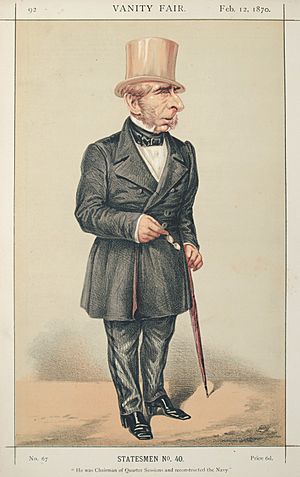John Pakington, 1st Baron Hampton facts for kids
Quick facts for kids
The Lord Hampton
|
|
|---|---|

The 1st Baron Hampton, c. 1867
|
|
| Secretary of State for War and the Colonies | |
| In office 17 February 1852 – 17 December 1852 |
|
| Monarch | Queen Victoria |
| Prime Minister | The Earl of Derby |
| Preceded by | The Earl Grey |
| Succeeded by | The Duke of Newcastle |
| Secretary of State for War | |
| In office 8 March 1867 – 1 December 1868 |
|
| Monarch | Queen Victoria |
| Prime Minister | The Earl of Derby Benjamin Disraeli |
| Preceded by | Jonathan Peel |
| Succeeded by | Edward Cardwell |
| Personal details | |
| Born | 20 February 1799 |
| Died | 9 April 1880 (aged 81) Eaton Square, London |
| Nationality | British |
| Political party | Conservative |
| Spouses | (1) Mary Slaney (d. 1843) (2) Augusta Murray (d. 1848) (3) Augusta de Crespigny |
| Alma mater | Oriel College, Oxford |
John Somerset Pakington, 1st Baron Hampton (born February 20, 1799 – died April 9, 1880) was an important British politician. He was a member of the Conservative Party. He was also known as Sir John Pakington, Bt for many years.
Contents
Early Life and Education
John Somerset Russell was born in a place called Slaughter's Court in Powick, Worcestershire. His mother was Elizabeth Pakington. She was from the important Pakington family.
John's father was William Russell, a lawyer and judge. Sadly, John became an orphan when his mother died in 1813. He went to school at Eton College. Later, he studied at Oriel College, Oxford.
In 1819, his older brother William died. This made John the main heir to his family's wealth. He left Oxford without finishing his degree. In 1831, he officially changed his last name to Pakington. This was because he had inherited land from his mother's family. He moved to Westwood House, Worcestershire in 1832.
Political Career Highlights
Pakington became a Member of Parliament (MP) for Droitwich in 1837. He was a member of the Conservative Party. He held this seat in Parliament until 1874.
He was known as a "liberal conservative." This means he was a Conservative but supported some progressive ideas. In 1846, he was given the special title of Baronet Pakington.
Key Roles in Government
Pakington held several important jobs in the British government.
- Secretary of State for War and the Colonies: In 1852, he served in this role. He announced the end of sending prisoners to Van Diemen's Land (now Tasmania). He also helped New South Wales get its own government. He also helped New Zealand get a new constitution.
- First Lord of the Admiralty: He was in charge of the Royal Navy from 1858 to 1859 and again from 1866 to 1867. During his time, he ordered the building of HMS Warrior. This was the first ironclad warship. It was a very important step in naval history.
- Secretary of State for War: From 1867 to 1868, he was in charge of the army.
He also became a member of the Privy Council in 1852. This is a group of important advisors to the Queen. He was also made a Knight Grand Cross of the Order of the Bath (GCB) in 1859. This is a very high honor.
Focus on Education
Pakington was very interested in improving education. He worked on reforms while his party was not in power. He was part of a special committee that looked after public money for primary schools.
In 1855, he tried to pass a new Education Bill. This bill was not successful, but it helped pave the way for future education laws. He also led the Pakington Inquiry on education in 1865.
Later Life and Honors
In 1871, Pakington spoke about a "New Social Alliance." This was an idea to bring together Conservative leaders and workers' representatives. He believed in social reforms.
In 1874, Pakington lost his seat in Parliament. However, he was then given a special title. He became Baron Hampton, which made him a member of the House of Lords.
He also held other important public jobs. He was the chairman of the Worcestershire Quarter Sessions for many years. He was elected a Fellow of the Royal Society in 1858. This is a very respected group of scientists. He was also the President of the Royal Statistical Society from 1861 to 1863. From 1875 until his death, he was the Chief Civil Service Commissioner.
Death and Family
Lord Hampton passed away at his home in London in April 1880. He was 81 years old. His son, John Slaney Pakington, became the 2nd Baron Hampton.
He was married three times:
- First, to Mary Slaney in 1822. She died in 1843.
- Second, to Augusta Murray in 1844. She died in 1848.
- Third, to Augusta Anne de Crespigny in 1851.
He had children from his first two marriages. His family continued to hold the title of Baron Hampton after him.


